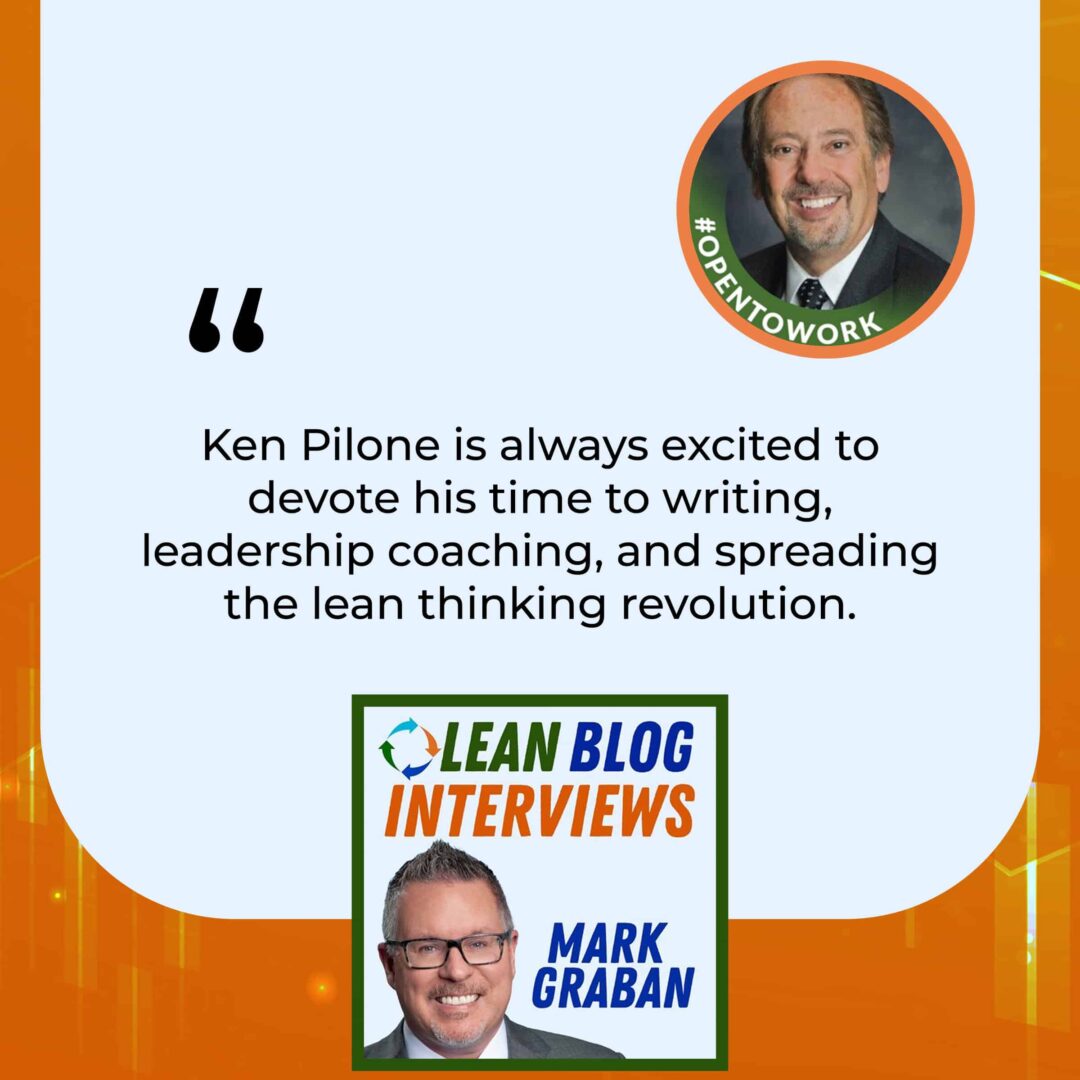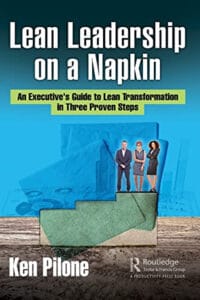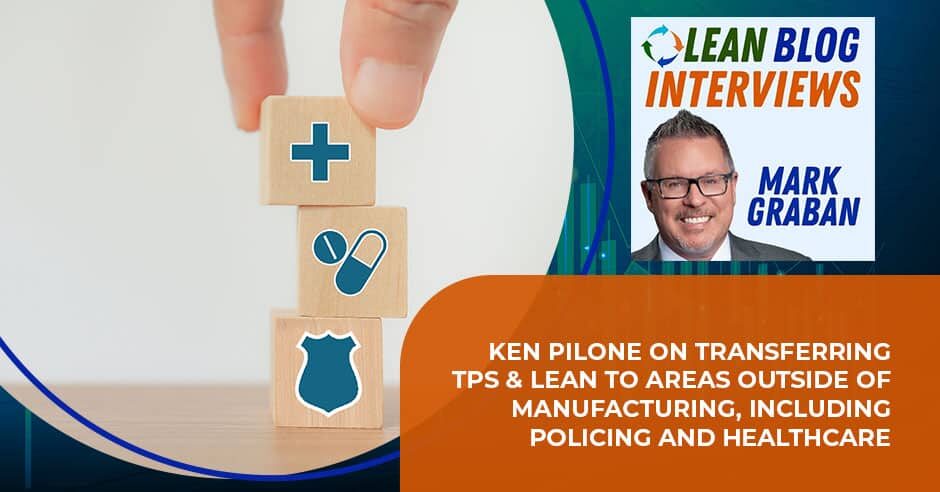Joining us for Episode #476 of the Lean Blog Interviews Podcast is Ken Pilone, who has more than 30 years' experience in Organization Development in government, retail, automotive, distribution, and aerospace.
He recently retired from Providence Health & Services, working most recently as the Senior Manager of Business Process Engineering at Providence Health & Services — a role that encompassed internal Lean consulting, including executive coaching, lean training, leadership development, and all functions typical of a lean promotion or PI/CI function.
He's now working as an independent coach.
He spent nearly 20 years with Toyota as Lean consultant within the company as well as with suppliers, vendors, partners, and community groups. He a co-creator of the University of Toyota at the company HQ. He led the work to adapt the Toyota Production System to non-production environments (warehousing, supply chain, HQ administration departments, sales, product distribution, dealer operations, etc.). In addition, he led the Center for Lean Thinking.
Ken has a Masters in Industrial Psychology and Organizational Development. With his Toyota experience, Ken has developed specialties in Lean consulting in non-production environments, curriculum development and delivery, leadership and management development coaching, Toyota problem-solving method training, and public speaking.
He's the author of Lean Leadership on a Napkin: An Executive's Guide to Lean Transformation in Three Proven Steps.
In today's episode, we discuss the application of Lean in healthcare and Ken's experience there… and more!
Questions, Notes, and Highlights:
- Police work? LAPD
- Viewing work as a process…
- Helping people see that in healthcare? How to go about that?
- Not using the term “value streams”
- Fixing defects vs. fixing the system?
- Defects in policing paperwork in the field
- Correcting the paperwork vs. why it occurred
- Process is broken — Band-Aids
- No time… why? How can we create time?
- Microexperiments vs. implementing? How to help people look at improvements as experiments?
- Psychological safety – removing the danger?
- “Never Events”? Zero Harm?
- JPL – process gremlins and being proactive…
- “Breaking the system on purpose”
- Adapting to healthcare… Tell us about your later transition into working in healthcare? Pulled or pushed?
- The importance of leading with humility? How to build that?
The podcast is sponsored by Stiles Associates, now in its 30th year of business. They are the go-to Lean recruiting firm serving the manufacturing, private equity, and healthcare industries. Learn more.
This podcast is part of the #LeanCommunicators network.
Listen to the podcast here
Ken Pilone On Transferring TPS & Lean To Areas Outside Of Manufacturing, Including Policing And Healthcare

Welcome back to the show. This is episode 476. You'll learn more about him later, but our guest is returning guest Ken Pilone. We're going to be talking about how his knowledge and experience from Toyota carried forward into work he did in other settings, including the Los Angeles Police Department and healthcare organizations.
—
Welcome back to the show. My guest, Ken Pilone, is a returning guest. He was here for episode 455 on August 24th, 2022. Ken is the author of the book Lean Leadership on a Napkin: An Executive's Guide to Lean Transformation in Three Proven Steps. This episode is part two. There's so much we have to talk about, Ken. Thank you for being back here on the show. How are you?
I'm doing great. I'm so glad to be back. Thanks.
I'm putting you on the spot. Maybe there's going to be a part three in our future. We're always going to find something.
I'm all for it. This is a never-ending topic.
I did a more formal introduction of you last time. This time, let me put that on you. I'm going to ask you to reintroduce yourself and summarize yourself and your background.
I've been doing this Lean thing for many years. I was twenty years at Toyota headquarters, where I taught Lean internally to new suppliers, partners, and affiliates of all kinds and adapted the Toyota production system into a white-collar environment. This thing we call Lean could be exported beyond the factory floor.
After I retired from Toyota, I started my own consulting practice and tried to spread the Lean word across other industries. I worked in police work, banking, construction, and healthcare. Ultimately, my work with healthcare led me to a second career in healthcare, where I worked with three separate hospital systems and tried to address the unique needs of healthcare with the Lean perspective. I retired again in December 2022.
Congratulations on that.
Thank you. I tried it twice before. It didn't work out that well.
Good luck this time. Better luck this time
Thank you.
We still have a lot to share and a lot to teach. You may able very well get pulled back into something. As you went through those different situations or professions that you were working with, this leap from the factory floor, not just white-collar functions within Toyota, police work is one of those that you said. Is that right?
Yeah. I worked for the LAPD. In fact, I had gotten an honorary commission into LAPD for the work that I and some of my colleagues did there to try to streamline and improve the policing process. It is everything from arresting, feeding, taking care of medical needs, house jailing, and that whole process. There are many different sub-processes in police work as there are in everything else. We teased it apart and helped them figure out how to do things in a more efficient way.
There's that opportunity to view all or most work as a process. That's something that is often not taught in a lot of settings, including healthcare. People are doing work. They're doing a lot of tasks. They know how to do those tasks, but how do we help them see what they're doing as being part of a process that involves the work of others and maybe even a system or a value stream? That's one of the big opportunities in healthcare to help people see that, right?
Yeah. It's interesting because, as you correctly pointed out, there are processes everywhere. Over the years, I've stopped using terms like value stream because it's a little off-putting to people sometimes. They don't know what we're talking about like it's Greek. When we talk about process improvement, it is pretty straightforward inefficiencies and things of that nature. It is always about a process. People tend to focus on fixing defects rather than addressing the cause of the defects. They fix this defect and go on and wait for the next one.
People tend to focus on fixing defects rather than addressing the cause of the defects. Share on XCan you give an example of fixing the problem versus fixing the system?
Yeah. One of them that comes to mind is, and this goes back to policing, where there would be defects created from the paperwork that was completed in the field by the arresting officers, let's say. They come in and then they have to go back and try to figure out how to correct the paperwork. It may have been weeks earlier that the defect occurred and they're going to have to go back and figure out, “What happened? This paperwork is either incomplete, redundant, contradictory, or whatever.” They try to scramble around to try to figure out how to fix it rather than trying to unravel how the defect occurred in the first place. They end up untying the same knots over and over again.
There are parallels in healthcare. One example that comes to mind for me would be, let's say, in the operating room. If an instrument is broken or was dropped on the floor or didn't look like it had been properly sterilized, there's this reactive process. The technologies have changed. People might call it flash sterilization. It's a rework process of, “There's a problem. There's a defect.” How do we get better at fixing the defect as opposed to going back and asking, “Why are we having to do this?”
That's exactly right. There are thousands of examples of that in rework associated with that in healthcare. It's so daunting. You almost don't know where to start when you're dealing with healthcare.
There are big opportunities. It's not even so much as this process view, but, I'm sure, as you've seen, it could be transferrable. There are things we might call mindsets, cultures, behaviors, principles, or management systems that can be applied in ways that are powerful. People in different industries have trouble seeing the relevance.
I'll admit to being a little bit upset by it. It was somebody being diminishing in manufacturing. They were like, “That's easy.” Those are words to me spoken by somebody who's never been in a factory. You and I are working in a hospital. We might be the only ones in the room who's been in both settings, so we can understand. What can we do to try to better engage other than maybe avoiding some jargon that might be off-putting?
It's interesting. One of the things that I summarized in my experience in healthcare is in the system that I've worked in in the actual hospital and the acute settings, things are moving so fast. A) There's the likelihood of error increasing greatly. B) It's been my experience that they know that the process is broken, but all they have time for are Band-Aids over the errors. They consistently are spray painting over the rust because that's all they have time for. It's endemic. All this gravitational pull in the healthcare systems with respect to Lean is this crazy pace that they're constantly under.
As a quick aside, when I worked for Johnson & Johnson, my first step into healthcare in 2005 to 2009, because Band-Aid was a brand of Johnson and Johnson, a different part of the company, we got told, “When you're in there working with hospitals, we don't like to say Band-Aiding a process. Don't use our brand name that way.” I'm like, “We could adhesive bandage the process.”
There's a lot of that. It's funny to think about the Band-Aid admonishment that we got. This question of we don't have time to improve, how do we help shift that from being an excuse? It might be the reality at the moment, but not letting it be an excuse and having that be a problem to solve. To create time, if we agree we need to improve, it seems like that's the challenge. It's to create time.
Rarely do you have to defend the need to do the work. They almost all agree. I agree with you. We need to get to the root cause. We need to stop solving these symptoms over and over again, but how do we do that in the context of this pace that we're at? They're constantly fighting fires. It's not the need. That was a mistake I made early on in healthcare. I spent way too much time trying to sell them on the need for improvement. I was like, “Here are all the things that you'll gain from this improvement.” They got that right away. They said, “Help me untie these knots. That would be great.”

That became more of an emphasis on providing external support where we would pull on clinicians and others on an adjusting time basis to do that process work. Me, my team and others would do the work for them in terms of trying to understand their value streams, the process that needs to be improved, and so on. We augment their own work and then bring them in periodically throughout the process to respect their time. We would say, “Give me an hour. We want to tell you where we're at right now. We appreciate some steering signals. Are we on the right track? Go back to doing what you do on the floor.” That was the one thing that I feel like folks like me inside the hospital system or consultants, if they are using them, have an advantage to affect your manufacturing time for them.
It could be using that time selectively and judiciously.
We'd be like, “Here's what we found, and here's our fix. Is it a go or no go?”
You were talking about some of that process of updating physicians, let's say, of where we're at. Who was we? Was that you and other process improvement specialists or you and other staff whose time could be freed up? Is it other clinicians?
It's a little of both. Not all aspects of the hospital are as frantic as the clinical staff is. A lot of problems need to be fixed, even on the facility side or housekeeping side, where those people have a little bit more latitude. It is not a lot, but a little bit more latitude as far as time goes. We would use those people and pull those resources out. Primarily, the heavy lifting was with myself and the operational excellence teams. That goes by many names like the Lean teams, LPOs, or whatever the internal organization was. We are supporting them through a contract basis on consulting work.
The health system can choose to pay them an hourly rate to do improvement work. If it's physicians or surgeons who are not directly employed, this is a situation of are you asking them to volunteer their time? If they're giving up clinical work that they're getting paid for, how do you try to compensate them for that? Some health systems have tried to provide compensation. It didn't make them whole, but it was something. Was that ever a part of it at the systems you worked in?
Yeah, and in particular, when it came to including physicians or more expensive clinical people like the surgeons and people like that. We did bring them in. They were compensated fully for their time, which we had to be careful with because you're bouncing on a beach ball. You're trying to save some time and money. Yet, at the same time, you're burning it on the other side. It does require, using the word you used, judicious use of time and resources. That requires a lot of backend planning. Who exactly do we need? Do we need a group of surgeons or do we need one who can speak for others or things of that nature?
Continuing on this topic of creating time or choosing to invest in improvement, I can't help but think back to one of the times I visited the Toyota truck plant in San Antonio, TMMTX. We would go there with healthcare people. I remember one tour during the Q&A session with the team member. This is back when it was a job assignment for a full-time team member. They've switched to full-time tour guides, which probably they can't give you the same kind of good answer.
The question was, you talk about the importance of kaizen and continuous improvement. Everybody looked busy. Not frantically so, but people were building trucks. People are doing work. It was like, “How do you make time? How do you find time to do kaizen?” The team member described, “If we don't find time to work it in during the day, our supervisor will approve us to work overtime.” You should have seen the jaws drop of the healthcare people. I'm like, “What?” They're like, “Overtime's bad.” Used judiciously, it could be viewed as an investment and not a cost, right?
Yeah. We did that on rare occasions. You do get a lot of pushback on that. The least of which was most people that would be there are present working overtime because they're already exhausted. These are people that work twelve-hour shifts to begin with. That was something we used, but rarely.
I've seen some hospitals not asking people to extend the already twelve-hour-plus day but scheduling improvement days. Instead of coming in and doing a clinical shift, to come in and do improvement, that would be a different way. At least I've seen some health systems address that.
The other thing is worth thinking through, and that is the benefit of having huddles. Those are fairly routine in clinical settings. Whether or not they have Lean methodology on a conscious, deliberate basis, almost everybody has huddled. If that's an opportunity to get the right people in the right place where we can talk about errors with a small window of time but help them think through what they can do in the next shift, that would be different. It's like, “What's one thing that we can do tomorrow or on the second shift?” Those little micro experiments to say, “Let's try X instead of Y on the next shift, and then in the next huddle, let's talk about what happened,” turned out to be pretty effective. They were capitalizing on what infrastructure already existed.

You're bringing up another important wing. I call it a mindset or a practice of the small experiment, the micro experiment, the small test of change, or the PDSA cycles as opposed to, “We're going to go implement that in a straight line way.” Do you have any advice on how we can try to influence people to look at improvements as experiments?
Yeah. First of all, the advantage you have in healthcare is most of the people on the clinical side at least are schooled in the scientific method. You have that going for you. You have PCA in the background and they're thinking. One of the things that I've found is, generally speaking, people already have some ideas about how to improve it. You give them an outlet, like through a huddle, where you are like, “Has anybody got something that you think would work better that we can try today?”
Once people get comfortable with it and they recognize it is okay to fail and it is okay to make a mistake, and the way we're going to learn is by experimenting, and that you get kudos for trying, once you tap into that, you gain some additional momentum. People on the sidelines tend to come forward more easily. Those people that are a little shy or reticent start to see that there's no real danger in holding your hand up and that failure is equally accepted as a success because of what we can learn from it.
In that process of tapping on the background that they already have in the scientific method, it took me years to develop that acuity as to where to start, how to start, and where the right place is. It reminds me in a way of the game Jenga. It is where you stare at this tower for a while until you finally figure out, “What's the one thing that I can do that will have the maximum benefit with the least amount of effort?”
Once you've touched that piece, you have to pull it.
You got to pull it. You got to try.
It's maybe more of a do-or-die PDSA cycle. Let's go back to your point about mistakes and failures. You're touching on what a lot of people would describe as psychological safety, like removing the danger and helping create the conditions where it's safe to speak up or where it's safe to try something. There are different types of failures. There's a “failure” in the attempt of trying to improve a process. That's learning. We expect that. We accept that.
In healthcare, there are other mistakes or failures that, unfortunately, can cause harm or death. It seems like trying to get in front of the mistakes, defects, or harm of identifying the risks, trying some improvements, and realizing if we're honest and safe to fail in our attempts to improve, we're going to find the right improvements that then might prevent the mistakes that cause harm. It's a roundabout way of trying to wrap my head around that. Saying we expect to fail and learn from it during improvement is different than saying, “You gave the wrong medication. That's no big deal because we're going to fail.” I know that's not what you're suggesting.
One of the things I learned in healthcare that is different from other industries is what they call never events. Those are certain things that can never happen, like wrong-side surgeries and things of that nature. What I found is that the teams that work on these things are self-regulating. They already know and police each other on it. They're like, “I get you want to re-label this medication, but what happens if we do it wrong?”
My job as a facilitator is to make sure that conversation happens, but it's not a hard sell. Nobody wants to cause an accident or be part of an accident. There's so much opportunity here that does not represent the potential for harm. We would stay away from those kinds of things, but it doesn't, by any means, stop you. Everywhere you look, there are opportunities.

I agree with you that people don't want to cause harm. People want to do the right thing in the right way with the right outcomes. I have heard time in timezone in healthcare this self-defeating prophecy where people get upset about languages like never events or zero harm. They say, “That's not possible. These things are going to happen.” That upsets me.
I think back to a different mindset from Paul O'Neill, the late former CEO of Alcoa, who would react to, “We can't do that,” by saying, “We haven't figured out how yet.” That might cause eye rolls or somebody to glare at you. It's frustrating to me sometimes when healthcare will say, “We're different.” Yes, you are. They're like, “What we do is so important.” Agreed. Yes, it is. They'll then say, “These things are going to happen.” It's not dismissive, but I feel like, “We haven't been able to solve it yet, so don't make us feel bad.” I don't know. That's frustrating. I'm sorry. I don't know if I'm up on a soapbox or laying on a therapy couch here. I'm sorry.
Not at all. I'm reminded of the aviation industry. No one that I can imagine would advocate making a change to an aircraft design, procedure, checklist, or whatever that had the potential for the airplane to crash. This is the healthcare equivalent of that. We're not going to crash anything. We're smart enough people. In fact, I did some work with NASA, interestingly enough, when they landed the first Mars rover.
I worked with JPL on that with NASA when I was still with Toyota. We were asked to come out there and watch their procedures. This is about as sophisticated a group of people as you can imagine working with. It was very humbling because you're working with people that are designing these crazy things and driving around on Mars. It was one of the earliest ones.
Imagine engineers sitting around in cubicles in a circle and in the center of the room is what they call the playpen. In this playpen is a simulation of the Mars surface and the spacecraft, the rover. What they did was they would design it. They were trying to figure out how to overcome any realistic failure while it was still here in the playground rather than waiting until it was on Mars.
They're being proactive.
What they did was they employed what they called a gremlin. The gremlin was a person who came in after everybody else had gone home. He was the only one allowed to touch the spacecraft. He went in to break an antenna. The next morning, the engineers would have to determine what had happened and then how do they fix it remotely. Are they able to? If not, go back to the drawing board and figure it out. Realistically, an antenna could break in the Martian winds or whatever.
They did this over and over again until the gremlin could no longer think of anything to do that they couldn't work around. He would take a wheel off and do all kinds of weird things. There's something to be learned there about practicing in the healthcare environment, particularly where the risks are so great that breaking the system on purpose in order to show where the weak link is and doing that through repeated rehearsal until finally, it's pretty much nailed down.
It's like process simulation. In healthcare, people might do different types of medical simulations. From a process or a systems level, I could see where that would be powerful to think about what could go wrong instead of reacting to the things that have gone wrong.
Assume it's going to work perfectly before they implement it. I'll say, “We're going to do this.” In some cases, that's worthwhile as a mini experiment or what have you. There's something to be said for taking a deep breath and saying, “What could go wrong? Let's simulate it. Let's break it. Let's bring in a gremlin. Let's do something until we feel confident.” Particularly if it's a super important activity that has to go right, then it's worth taking the time to do that.
There's something to be said for taking a deep breath and saying, 'What could go wrong? Let's simulate it. Let's break it down and do something until we feel confident.' Share on XTo me, that's a good engineering mindset. I've run across at times people in healthcare who are completely uncomfortable with the conversation of talking about what could go wrong in a way that seems superstitious, not scientific. This stuff is so important. We should be thinking through this. It goes back to the thing that's true, but then, now what?
The statement, “Healthcare is different,” I hear that as a way of being defensive or dismissive. They're like, “We're different.” Back in aviation, I saw a thing. I got to quit reading stuff that upsets me. I've already stopped getting upset. It was a physician. I was disappointed to see him being fed up with trying to make healthcare learn from other industries. He was like, “Enough. Healthcare is different.”
I'll tell you one-way aviation is different. The pilot is in it with me. I know that pilot gives a dang about preventing safety problems because they're in it with me. The surgeon, they're not. I'm not saying any surgeons are wanting to harm people, but it's different. That's a case where healthcare needs to be better, not different, because of the importance of trying to think, “What do we have to figure out on how to prevent this?” instead of saying, “It's sad, but these things happen.” We wouldn't accept that in aviation.
A way to knock down some of that resistance, which I found, too, is to separate out in healthcare where there are quasi-production lines. Even in clinical space, like a cath lab, for example, it is so routine that they spin the wheel and do the same thing over and over. That's starting to sound like production to me. It is by using that type of work as a beachhead that we can say, “Let's look at this. I know it's different, but this is the most like manufacturing.”
Be careful saying that.
In my head, I'm thinking, “I can use in a pretty direct way the things that I've learned in a production environment in this environment.” There are enough of those repetitive processes in radiology and places like that where you can bring to the table what you have in your production and manufacturing background in a way that can show significant results and gain you some goodwill.
You have all these experiences not just at Toyota but in other types of settings. When you first got into healthcare, were you pulled into it in some way or were you pushing because that was someplace you wanted to go help and try to make a difference?
I got in it by accident because a friend of mine that had worked for Toyota had gone to work for Hoag Health Systems as a senior VP there over real estate facilities. I forget what the other one is. It was because of his Toyota background that he felt like he was speaking Greek to his staff. He had hundreds of people working for him. He asked me to come in and teach A3 thinking. That was my first exposure to healthcare.
As part of the A3 thinking workshop that I did, there was time set aside for them to not only write A3 but to go experiment, carry it out, and bring it back so they would have some results to work with. It was so popular that other people outside his domain were coming. Eventually, this thing had so much momentum that they ended up deciding to make an internal Lean function. My contract shifted to the creation of capability internally.
I remember one moment when the CEO of the organization was in one of my workshops. He asked me during a break if he could comment to the group when we reconvened. I was nervous. I was like, “What's he going to say?” He came back and I said, “Sure.” He said something I never forgot. He said, “This process that we're going through here is allowing us to speak a common language from the clinical to the nonclinical groups by using A3 thinking, PDCA embedded logic, and all that.”
He said, “This has been a disconnect for us. We have the clinicians speaking one language and the non-clinicians speaking another language. We never seem to connect.” What I coined with him was the notion of applied common sense. He said, “By using facts, data, and information and talking in terms of the PDCA cycle, not only are we going to get improvement, but we're going to collaborate better.” I never forgot that. It was an insight that I hadn't had before. It turned me on to the healthcare industry after that. I could see immediate improvements in the things that we were doing, so I got hooked.
Our guest is Ken Pilone. His book is Lean Leadership on a Napkin: An Executive's Guide to Lean Transformation in Three Proven Steps. One thing you wrote about in the book that stood out to me about A3 is you called it a quasi-linear process. If we have an A3 template and you've got your different boxes and your steps, tell us more about being “quasi-linear.”

If you look at a typical A3 template that you download off Google, the first thing that strikes you is that it's a sequential linear thing. You start with the background and then you're going to go to the current state. Implied in that is this notion that you can't go backward. In fact, the reality is the opposite of that. You may have a starting point you may have designed, but you may run into something that causes you to rethink the root cause, for example.
You've learned something more.
You've learned something, so you may have to go back. Sometimes, people will start with an action and then go backwards and go, “Why did we take this action?” It is one of those things where you can enter at any point and then follow the methodology. You are keeping in mind that it is not only okay, but it's expected that you're going to have to go backward from time to time, if you want to call it backward. You're like, “I should learn new things and reframe it. The whole problem might change.”
When you learn new things and reframe the methodology, the whole problem might change. Share on XI'm surprised to hear you talk about starting with the solution. It seems like there could be a case where you're going back and you're checking the logic in an honest, open, and inquisitive way as opposed to force-fitting, “I'm going to do the solution I wanted, but they told me I had to do an A3.” There's a difference between going and checking the thought process versus going through the motions, right?
Yeah. The effect of doing that is you catch people doing things approximately right. They had a solution and gave some thought to it. It's like, “Let's put the rigor of the A3 behind it and see if we can figure out why you didn't get the results you thought you were going to get. What was the problem you were trying to solve?” They will spout off some opinions. It's then like, “What are the facts that gave you that opinion?” As they start to hear themselves work through it, they start to ease their way back into the logic of A3. Some people automatically do that. It's the way they think. I'm not one of those people.
If they have a good coach like you, they might catch some flaw in the logic or flaw in the thinking that puts them on the path to, “Maybe it's a different countermeasure that we should try.” They might understand by going through the A3. They're like, “We've discovered something. Let's try a different countermeasure and predict and then see whether we are getting the results we expected or not.”
Sometimes, it's as simple as, “Did I include the right stakeholders from the beginning?” All of a sudden, they're dealing with resistance. They go, “This makes perfect sense. I've thought it out and I've thrown it into the pond.” All of a sudden, people are balking. It's like, “How much stake did they have in the process to get you there?” None. That's what I'm paid to do. It's to problem solve. Here's a solution. Go do it. That is where we part ways a little bit from the Six Sigma movement.
That might be a topic, plus some other things for part three. I know you need to run again. Thank you for being here for part two. I'd love to do another episode with you at some point.
I look forward to that. It's always fun. It stretches my thinking. I appreciate it very much.
I'm glad. Thank you for that. You set a good example that you're still reflecting, learning, and thinking through these things. Thank you for that. I try my best to do the same. We've been joined by Ken Pilone. Go check out his book, Lean Leadership on a Napkin. Go back if you haven't already checked out episode 455. Thanks for being here again, and I hope to do it again someday.
Thanks. I'll look forward to it.
Important Links
- Ken Pilone
- Episode 455 – Ken Pilone, The Author of Lean Leadership on a Napkin; Toyota Says “Lean” and More
- Lean Leadership on a Napkin: An Executive's Guide to Lean Transformation in Three Proven Steps
- https://LeanExecs.com/
What do you think? Please scroll down (or click) to post a comment. Or please share the post with your thoughts on LinkedIn – and follow me or connect with me there.
Did you like this post? Make sure you don't miss a post or podcast — Subscribe to get notified about posts via email daily or weekly.
Check out my latest book, The Mistakes That Make Us: Cultivating a Culture of Learning and Innovation:












As shared by Alexander Berk on LinkedIn:
An interesting podcast about LEAN in non-manufacturing environments (Police & Healthcare).
3 practical insights I took away:
– “it is always about a process and people tend to focus on fixing defects rather than addressing the cause of the defects.”
– “I spent way too much time trying to sell them [healthcare professionals] on the need for improvement.”
– “little micro experiments […] let’s try X instead of Y on the next shift and then on next huddle, let’s talk about what happened. That turned out to be pretty effective, capitalizing on what infrastructure already existed.”